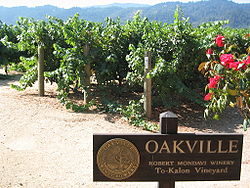Oakville, California
| Oakville | |
|---|---|
| Census-designated place | |

To-Kalon Vineyard, Robert Mondavi Winery, Oakville, California
|
|
| Location within the state of California | |
| Coordinates: 38°26′13″N 122°24′4″W / 38.43694°N 122.40111°WCoordinates: 38°26′13″N 122°24′4″W / 38.43694°N 122.40111°W | |
| Country |
|
| State |
|
| County | Napa |
| Area | |
| • Total | 1.360 sq mi (3.522 km2) |
| • Land | 1.360 sq mi (3.522 km2) |
| • Water | 0 sq mi (0 km2) 0% |
| Elevation | 154 ft (47 m) |
| Population (2010) | |
| • Total | 71 |
| • Density | 52/sq mi (20/km2) |
| Time zone | Pacific (PST) (UTC-8) |
| • Summer (DST) | PDT (UTC-7) |
| ZIP codes | 94562 |
| Area code(s) | 707 |
| GNIS feature IDs | 229899; 2583102 |
| U.S. Geological Survey Geographic Names Information System: Oakville, California; U.S. Geological Survey Geographic Names Information System: Oakville, California | |
Oakville is a census-designated place (CDP) in the Napa Valley of Napa County, northern California.
The population was 71 at the 2010 census.
The local economy is based on Napa Valley wine production, and Oakville was formally declared a distinct appellation within the Napa Valley AVA in 1993. There are currently 24 wineries and over 5,000 acres (20 km2) of vineyard located within the boundary of the Oakville AVA, among them are the Robert Mondavi Winery, the Opus One Winery, and wineries of Heitz Wine Cellars and Screaming Eagle.
Oakville started life in the 1860s as a water stop for the steam train owned by The Napa Valley Railroad Company. The railroad, founded by early California pioneer Samuel Brannan in 1864 shuttled tourists between ferry boats that docked in Vallejo to the resort town of Calistoga. The village gained its name from the dense groves of dark green valley oaks of the area.
H. W. Crabb turned Oakville from untamed country to wine country after his 1868 purchase of 240 acres (1.0 km2) close to the Napa River. Crabb established a vineyard and winery naming it To Kalon, which in Greek means "the beautiful." By 1877 Crabb had planted 130 acres (0.5 km2) and was producing 50,000 gallons of wine per year and by 1880, his vineyard had increased to 430 acres (1.7 km2).
...
Wikipedia

